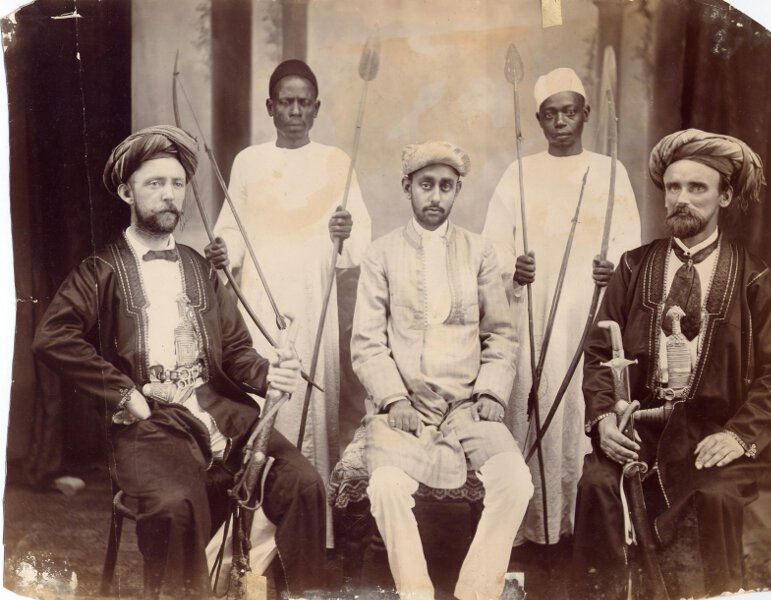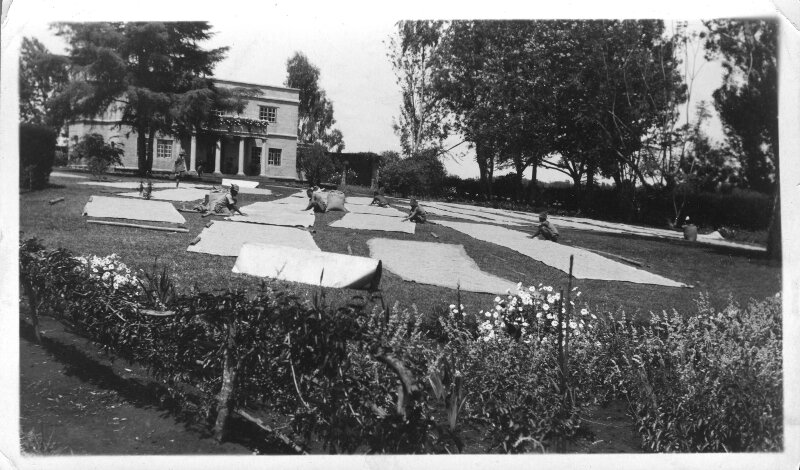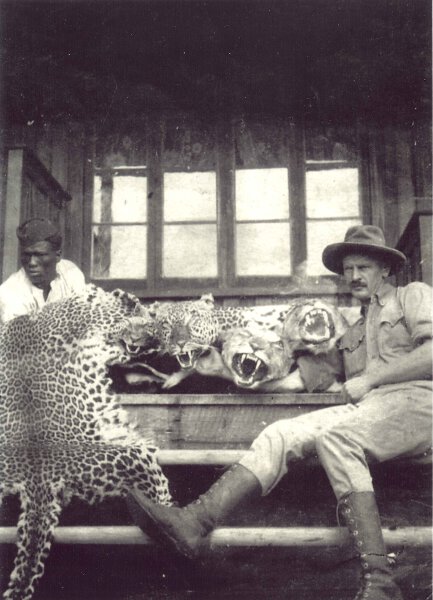-

Zanzibar, March 1895. Following the successful sale of their cargo from Lärkan, Jens J. Anderssen (left) and Oscar C. Olsen celebrated by having their photo taken. Both Norwegians are here dressed in Omani clothes, and adorned with status symbols such as the khanjar (dagger) and the rifle. The man in the middle is most likely Muhammad Juma, the Indian trader who bought the load off Lärkan. It is less clear who the men in the background are. They may be members of the "army" needed to carry all the silver rupees to the bank. They may also be professional posers used by some photographers to give provide their European clientele with an exotic touch. (Copyright: Private collection of the Olsen/Koren family and reproduced with kind permission.)
-

Eight years after the successful sale of the load from Lärkan, NEAT was an established company in Zanzibar. In this photo from 1903, the now well-established Olsen (left) exudes confidence, while the very young Christian Janssen (right) looks less certain in his new environment The man in the middle is most likely the Indian clerk whom Olsen described in his correspondence as a "young, clever and good-looking fellow." (Copyright: Private collection of the Olsen/Koren family and reproduced with kind permission.)
-

Olsen was gradually integrated into the British colonial society, as evidenced by this invitation to join the celebrations of the 60-year reign of Queen Victoria. (Copyright: Private collection of the Olsen/Koren family and reproduced with kind permission.)
-

Colonial days: The timber trader Olsen moves about town, pulled by Zanzibari manpower. (Copyright: Private collection of the Olsen/Koren family and reproduced with kind permission.)
-

Christian Thams (1867-1948), the first Norwegian owner of Madal - the enormous copra plantation in Northern Mozambique. Thams was involved in a number of large-scale colonial ventures across Africa and beyond and is here being carried in a so-called machila on one of his travels. (Copyright: Private collection of Elsa Reiersen and reproduced with kind permission.)
-

Map outlining the expanse of Madal's properties in 1918 in the "Province of Mozambique" - then formally a province in the Portuguese colonial empire. Madal's territories and stations are marked by red dots. (Copyright: Private collection of the Helmer family and reproduced with kind permission.)
-

At the Madal plantation in Mozambique, the scraping of coconuts is still the dominant way to extract copra in order to dry the meat. The work in 2007 (when this photo was taken) is almost as labor-intensive and non-mechanized as during the colonial era. (Copyright: Bjørn Enge Bertelsen)
-

African laborers, Norwegian whale boat crew, clerks and the manager and his family posing on top and in front of a large blue whale at the Donkergat whaling station, Saldanha Bay in the Cape Province, South Africa, 1919-20. (Copyright: The Whaling Museum archives in Sandefjord and reproduced with permission).
-

Grytviken, South Georgia in the 1920s: This land-based factory at Grytviken was the first to be established in the Southern Hemisphere in 1904. It was run by an Argentinean company, Argentina Compañia de Pesca Sociedad Anónima, but managed by Norwegians. In 1919-1920 a group of 26 Africans from South Africa were employed at the factory for a year. (Copyright: The Whaling Museum archives in Sandefjord and reproduced with permission).
-

Whale blubber cooking at the factory in Elephant Bay, Angola, 1924. The station was established in 1912 and run by a Norwegian company The South Atlantic Company. All stevedores at the station were Africans. (Copyright: The Whaling Museum archives in Sandefjord and reproduced with permission).
-

Thesen & Co steamer "Agnar" tows a cargo vessel through the Heads: Shipping and forestry was the backbone of the Thesen & Company. Creosote was shipped from northern Europe to the timber processing plants in South Africa. Entering the infamous Heads into the sheltered port of Knysna became easier when steamers were introduced. (Courtesy of Margaret Parkes Collection).
-

Throughout its century-long existence, forestry was the main economic activity for Thesen & Company. Wood processing plants and forestry employed a significant share of the labor force. There were also issues of antagonisms and conflicts between the woodcutters and the timber owners, and allegations of exploitation were raised by members of the Parliament in the 1930s. (Courtesy of Margaret Parkes Collection).
-

Thesen & Company were involved in a series of enterprises in addition to shipping and forestry, from oyster breeding and boat building, to transport companies, fishing and flour milling. Competing merchants alleged early in the twentieth century the company for occupying and monopolizing every possible economic niche - and becoming omnipotent entrepreneurs. (Courtesy of Western Cape Archives Repository).
-

Lars Nielsen, outside his trade store at Gavutu Island, ca 1890. Nielsen arrived in the Solomon Islands as a shipwrecked sailor in 1875 and was one of the very first Europeans to settle permanently in the archipelago. As a trader in most parts of the archipelago over 25 years, he survived several attacks by islanders, and ultimately built a small trading empire that included copra, bêche-de-mer, pear shell, control over the best port in the Solomons, and lucrative contracts for coal supply with the Royal Navy. About 1902, in failing health, he sold his properties to fellow Norwegian trader Oscar Svensen and left for Australia. (Photo: Private collection, by permission).
-

Dr. Jon Tikivanotau Jonassen, retired professor of political science at Brigham Young University-Hawai'i, by the Rarotonga grave of his grandfather Reinert G. Jonassen (1866-1921), the Norwegian sea captain who founded a family dynasty in the Cook Islands. (Photo: Edvard Hviding, 2012).
-

Ivory was the major export article of the Congo Freestate before the boom in natural rubber. The hunt for ivory both exploited the Congolese peoples and the natural resources. Motive from Nepoko, not dated. (Copyright Espen Wæhle, Martin Engh's photo album).
-

Some 2.000 Scandinavians served in the Congo from the 1870s to the 1930s. Here one of the Norwegian officer in the Congo colonial army Force Publiqe (number three from the left) Martin Engh, together with colleagues O'Brille, Moro & Hamau at the post Arumu in February 1909. Engh served both in the Lado enclave and in north-eastern Congo, "constantly waging war," as a Danish officer described it. (Martin Engh photo album). (Copyright Espen Wæhle, Martin Engh's photo album).
-

The Mangbetu chief Belia (and wife?) in his village, with officers of the colonial army, not dated. (Copyright Espen Wæhle, Martin Engh's photo album).
-

Wooden bark "Sirrah" built at Ugland Verft in the south of Norway in 1891: One of the many sailing ships involved in the global cargo business. (Copyright: Private collection of the Haave family and reproduced with kind permission by J.E. Haave.)
-

Rio de Janeiro 1912: Norwegian captain Jørgen Haave with wife and son plus crew on the Norwegian steel ship "Socotra" built in 1891. (Copyright: Private collection of the Haave family and reproduced with kind permission by J.E. Haave.)
-

Six-year-old Norwegian Bjørn Eriksen posing royally over houseboys employed at one of the Norwegian coffee farms in the Kenyan Highlands in 1930. A scene staged by Marius Riis employed as a manager by the Norwegian owners of AZANIA Ltd. Riis managed one of the farms, Kizembe Estate, from the First to the Second World War. (Copyright: Private collection of the Eriksen family and reproduced with kind permission by the late Bjørn Eriksen.)
-

Laborers at the Norwegian-owned coffee farm Yara Estate in the Kenyan Highlands just before the out brake of the First World War. (Copyright: Private collection of the Eriksen family and reproduced with kind permission by the late Bjørn Eriksen.)
-

Kenyan workers in the late 1930s, in front of the manager's house at the Norwegian owned farm Njuno Estate in the outskirts of Nairobi. (Copyright: Private collection of the Krag family and reproduced with kind permission by Didrik Krag.)
-

Scandinavian lunch get together in Nairobi during in the early 1950s. All white adults were ordered by the colonial authorities to carry handguns for protecting during the Kenyan liberation struggle Mau Mau. (Copyright: Private collection of the Aagaard family and reproduced with kind permission by Berit Aagaard.)
-

Harald Helvin Arnesen came to Kenya from Norway right before the First World War and joined the East African Military Regiment. After the war he moved to Tanganyika and worked in the lumber industry there until his death in 1955. The image indicates that Arnesen, like most white men living in Eastern Africa during the colonial period, took part in hunting as a leisure pursuit. (Copyright: Reproduced with kind permission by Olve Reiersen.)

See Related
History JournalsEmail Newsletters
Sign up for our email newsletters to get customized updates on new Berghahn publications.
Navigating Colonial Orders
Norwegian Entrepreneurship in Africa and Oceania
Edited by Kirsten Alsaker Kjerland and Bjørn Enge Bertelsen
414 pages, 36 illus., 2 tables, bibliog., index
ISBN 978-1-78238-539-4 $150.00/£115.00 / Hb / Published (November 2014)
eISBN 978-1-78238-540-0 eBook
Reviews
“Navigating Colonial Orders provides a novel prism in which to examine the informal imperial influence of ‘noncolonial colonials’, both European and non-European, who thrived in foreign imperial systems. While the work resists the generalising ‘shade’ of globalisation, the contributions illuminate the global nature of expanding social, economic and political exchanges that shape contemporary core–periphery interaction. Norwegian entrepreneurs in Africa and the Pacific, utilising expertise in shipping, management, whaling and timber, flourished in an environment of rapid industrialisation and vast economic exploitation. Navigating Colonial Orders proves that Norwegians were ‘integral to and complicit in’ the feeding frenzy of European colonial expansion.” · Journal of Pacific History
“This collection is an extremely informative and valuable addition to the field of Scandinavian colonialism studies and colonial history of Africa and the South Pacific illustrating the multiform and complex nature of the colonial systems.” · Journal of Colonialism and Colonial History
“This fascinating and deeply engaging volume makes a unique contribution not only to the study of Norwegian political and economic history from 1850 to 1950 but also to the interdisciplinary field of Postcolonial Studies. Through original and ground-breaking research, the contributors question the perception that Norway’s active role in the world at large came into being only in the modern era as a promoter of world peace and human rights… A counter-intuitive scrutiny of such popular assumptions through rigorous research – as the contributors to this volume have done – is of tremendous relevance to broader critical interrogations of the overlapping concepts of Nordic norm entrepreneurship and Nordic exceptionalism.” · Scandinavian Journal of History
“Navigating Colonial Orders is an extremely valuable record of geographically extensive and variously troubled and profitable Norwegian overseas adventures, enterprise and community from 1850 to 1950. Collated in a single, compelling collection, a series of painstakingly researched chapters by thirteen accomplished scholars examines Norwegian commerce, shipping, whaling, fishing, farming and forestry in Africa and the Pacific Islands….The presentations draw from an impressive range of primary archival material and secondary library material, and on the expertise of anthropologists, historians, a geographer and a political scientist.” · Gordon Pirie, University of Cape Town
Description
Norwegians in colonial Africa and Oceania had varying aspirations and adapted in different ways to changing social, political and geographical circumstances in foreign, colonial settings. They included Norwegian shipowners, captains, and diplomats; traders and whalers along the African coast and in Antarctica; large-scale plantation owners in Mozambique and Hawai’i; big business men in South Africa; jacks of all trades in the Solomon Islands; timber merchants on Zanzibar’ coffee farmers in Kenya; and King Leopold’s footmen in Congo. This collection reveals narratives of the colonial era that are often ignored or obscured by the national histories of former colonial powers. It charts the entrepreneurial routes chosen by various Norwegians and the places they ventured, while demonstrating the importance of recognizing the complicity of such “non-colonial colonials” for understanding the complexity of colonial history.
Kirsten Alsaker Kjerland is a historian with UiB Global at the University of Bergen. Beginning in 1999, she was part of a team of historians writing a history of Norwegian development aid, published in three volumes in 2003. She initiated the research project “In the Wake of Colonialism” and is the author of Nordmenn i det koloniale Kenya (Spartacus, 2010) and co-editor, with Knut Mikjel Rio, of Kolonitid: Nordmenn på eventyr og big business i Afrika og Stillehavet (Scandinavian Academic Press, 2009).
Bjørn Enge Bertelsen is Associate Professor in the Department of Social Anthropology at the University of Bergen. His articles have appeared in Journal of Southern African Studies, Social Analysis, Anthropology Today, and Urban Studies. He is the author of Violent Becomings: State Formation, Culture and Power in Mozambique (Berghahn Books, 2015, Open Access) and co-editor of Crisis of the State: War and Social Upheaval with Bruce Kapferer (Berghahn Books, 2009).




